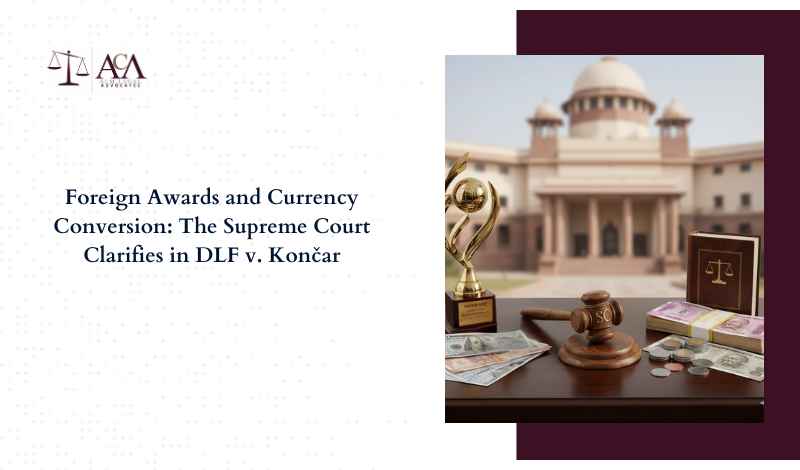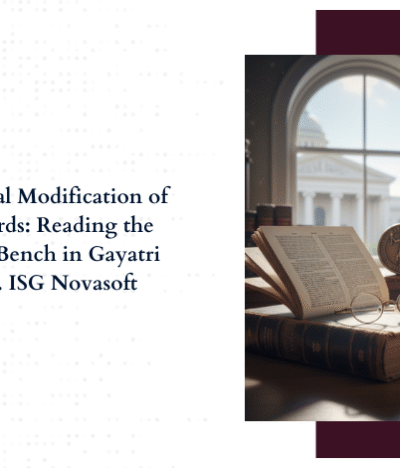When a foreign arbitral award is brought to India for enforcement, one practical but thorny issue immediately arises: at what date should the award amount be converted into Indian rupees? This question is not merely academic—exchange rates fluctuate daily, and a difference of months (sometimes even days) can mean crores of rupees in real execution value.
In DLF Ltd & Anr. v. Končar Generators and Motors Ltd., 2024 INSC 593, the Supreme Court confronted this very issue. The Court held that the “relevant date” for foreign exchange conversion is the date on which the foreign award becomes enforceable in India under Section 49 of the Arbitration and Conciliation Act, 1996. This ruling settles a long-standing uncertainty in cross-border enforcement. The Court also addressed how partial deposits made during enforcement proceedings should be handled, ensuring that parties neither gain an unfair windfall nor suffer double disadvantage because of timing mismatches.
The judgment is a reminder that arbitration enforcement is not just about legal principle but also about execution mathematics—what ultimately lands in the decree-holder’s account depends on precise rules of conversion, deposit, and adjustment.
Background of the Case
The dispute in DLF Ltd. v. Končar Generators and Motors Ltd. arose from a contract for supply of generators. The parties had agreed to arbitrate under the Rules of the International Chamber of Commerce (ICC). The tribunal seated outside India passed an award in favour of Končar, directing DLF to pay a sum denominated in euros along with interest.
Končar then moved the Delhi High Court for enforcement under Sections 47–49 of the Arbitration and Conciliation Act, 1996. DLF resisted enforcement on various grounds, but the High Court rejected its objections and held the award enforceable. The matter eventually reached the Supreme Court, not on the merits of the award, but on the mechanics of converting the foreign currency award into Indian rupees.
The practical problem was straightforward:
- The arbitral award was in euros.
- The exchange rate fluctuated significantly between the date of the award, the date of the High Court’s enforcement order, and the ongoing proceedings in the Supreme Court.
- DLF had made partial deposits in rupees during the pendency of enforcement, which created complications in calculating the final payable amount.
The Supreme Court had to decide:
- Which date controls the exchange rate—award date, filing date, enforcement order date, or final payment date?
- How should partial deposits be adjusted so that neither party gains an unfair benefit from currency volatility?
The Supreme Court’s Ruling
The Supreme Court in DLF v. Končar delivered a clear holding:
1. Relevant Date for Foreign Exchange Conversion
- The Court held that the date on which the award becomes enforceable under Section 49 of the Arbitration Act is the controlling date for currency conversion.
- In practical terms, this is the date when the enforcing court (here, the Delhi High Court) rules that the foreign award is a decree capable of execution in India.
- This approach strikes a balance: it avoids locking parties to an outdated exchange rate (like the award date) and prevents open-ended uncertainty of calculating at the final payment date.
2. Partial Deposits During Enforcement
- DLF had already deposited certain amounts in Indian rupees with the court during the enforcement proceedings. The question was how to treat these sums when the ultimate conversion from euros to rupees was done at the Section 49 enforceability date.
- The Court clarified that partial deposits must be given credit at the rate prevailing on the date of deposit, not retrospectively adjusted to the Section 49 date.
- This ensures fairness: if a judgment debtor deposits money early, they are not penalised by later currency fluctuations, and the award creditor receives credit at the value actually realised at that time.
3. No Double Benefit, No Double Loss
- The Court’s solution avoids two distortions that often plague enforcement:
- Windfall for the creditor if all deposits are revalued at a later higher rate.
- Unjust enrichment of the debtor if deposits made earlier are ignored in real value terms.
- The Court’s solution avoids two distortions that often plague enforcement:
By anchoring the principal conversion date at enforceability while treating interim deposits at their actual deposit dates, the Supreme Court laid down a workable and principled formula.
Applying the Rule: Execution Maths in Practice
The Supreme Court’s formula in DLF v. Končar only makes sense if you run the numbers. Let’s break it down with a simplified illustration:
Step 1: The Award
- Suppose the foreign award directs payment of €10 million plus interest.
Step 2: Date of Enforceability (Section 49 date)
- The Delhi High Court declares the award enforceable on, say, 1 January 2023.
- On that date, the euro-to-INR exchange rate is ₹85 per €.
- So, the enforceable decree is calculated as:
- €10,000,000 × ₹85 = ₹850 crore.
Step 3: Partial Deposit Before Enforcement Order
- Assume DLF had deposited ₹100 crore on 1 July 2022, when the rate was ₹80 per €.
- On that day, €1 = ₹80, so ₹100 crore equalled €12.5 million in real value terms.
- The Court credits this deposit at its actual realised value as on that date, not by reconverting at the later ₹85 rate.
Step 4: Adjusting the Balance
- Total liability at enforceability: ₹850 crore.
- Less credit for deposit: ₹100 crore (valued at time of deposit).
- Net balance payable: ₹750 crore (plus post-award interest, if applicable).
Step 5: Avoiding Currency Windfalls
- If the ₹100 crore deposit were wrongly reconverted at ₹85, it would show as only €11.76 million, reducing its value and unfairly penalising DLF.
- Conversely, if credited at the later ₹90 rate (hypothetically), Končar would receive a windfall beyond what was actually deposited.
Conclusion
DLF Ltd. v. Končar Generators sharpens the practical mechanics of enforcing foreign arbitral awards in India. By fixing the exchange rate on the date of enforceability under Section 49, the Supreme Court has given both creditors and debtors a predictable anchor. By simultaneously ensuring that partial deposits are valued at the date they were actually made, the Court has prevented both unfair dilution and opportunistic windfalls.
The ruling underscores a broader theme in arbitration law: enforcement is not only about abstract doctrines but about real-world execution maths. Crores of rupees can turn on whether a conversion is pegged to one date or another. With this judgment, India now has a principled, balanced formula that protects the integrity of foreign awards while ensuring fairness in currency-sensitive enforcement.





